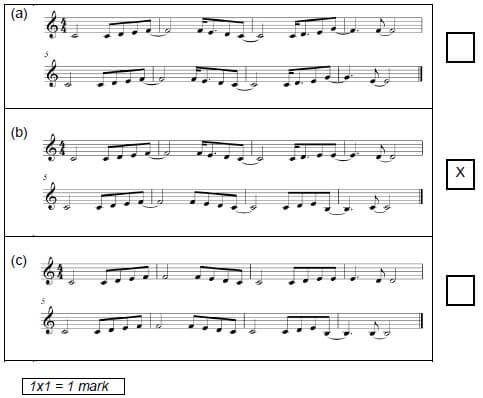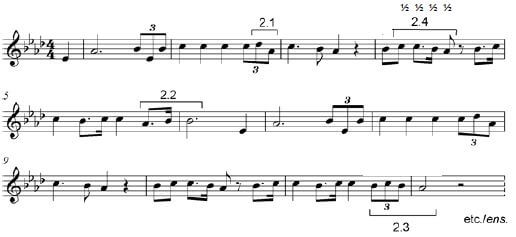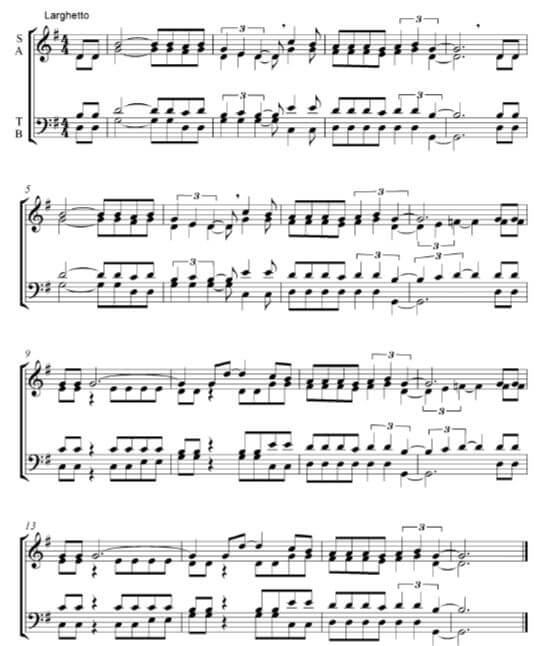MUSIC PAPER 2 GRADE 12 MEMORANDUM - NSC EXAMS PAST PAPERS AND MEMOS NOVEMBER 2018
Share via Whatsapp Join our WhatsApp Group Join our Telegram GroupMUSIC
PAPER 2
GRADE 12
NSC EXAMS
PAST PAPERS AND MEMOS NOVEMBER 2018
MEMORANDUM
Note to the marker: Candidates must be credited for any correct answers not given in the marking guidelines. |
SECTION A: AURAL
QUESTION 1
1.1 Listen to the melodic and rhythmic phrase. Notate the rhythm of the missing notes in bars 2–3 below.
Answer: ![]() (3)
(3)
1½ mark per bar as indicated = 3 marks |
1.2 Which ONE of the notations below best represents the solo voice part? Make a cross (X) in the appropriate block.  (1) [4]
(1) [4]
QUESTION 2
Listen to the extract below and answer the questions that follow. 
2.1 Name the interval formed between the Db note and the missing note in bar 24.
- Answer: Perfect 4th (1)
2.2 Which type of non-chordal note do you hear in bar 54?
- Answer: Anticipation (1)
2.3 Name the cadence at bars 11 to 12.
- Answer: Perfect cadence (1)
2.4 Listen to the music from bars 1 to 6. Some of the notation in bar 4 has been omitted from the score. Fill in the missing pitches and note values that correspond with the music that you hear.
- Answer: See score (2)
Correct pitches and note values = ½ mark each No mark for correct pitch or note value only |
2.5 Name the solo instrument that plays the melody line in this extract.
- Answer: Trumpet (1) [6]
TOTAL SECTION A: 10
SECTION B: RECOGNITION OF MUSIC CONCEPTS
QUESTION 3: GENERAL LISTENING (COMPULSORY)
Listen to the following tracks and answer the questions that follow.
Note to marker: if a candidate selected more items than requested, only the first answers must be marked. |
3.1 With which items in COLUMN A do you associate the music that you hear in Track 7? Make a cross (X) in THREE appropriate blocks.
Answer:
COLUMN A | Track 7 |
Chromatic passage | X |
Adagio | |
Duet | |
Allegretto | X |
String and wind quartet | |
Major key | X |
String quartet | X |
3x1 = 3 marks |
3.2 Which ONE of the following statements is correct? Make a cross (X) in the appropriate block.
Answer:
Statement | |
The extract consists of a motif, an imitation and an imperfect cadence | X |
The extract consists of a motif, inversion and an imperfect cadence | |
The extract consists of a motif, repetition and an imperfect cadence |
1 mark |
3.3 With which items in COLUMN A do you associate the music that you hear in Track 9? Make a cross (X) in THREE appropriate blocks.
Answer:
COLUMN A | Track 9 |
Vocal melody starts with an anacrusis | X |
Triple time | |
Quadruple time | X |
Swing/shuffle rhythm | X |
Guitar introduction | |
12-bar blues | |
Syllabic word setting | X |
3x1 = 3 marks |
3.4 With which items in COLUMN A do you associate the music that you hear in Track 10? Make a cross (X) in THREE appropriate blocks.
Answer:
COLUMN A | Track 10 |
Chordal accompaniment | X |
Allegro | |
Simple quadruple | X |
Compound triple | |
Guitar introduction | X |
Straight rhythm | X |
Alto voice | X |
3x1 = 3 marks |
3.5 Choose any TWO items in COLUMN A and identify what you hear, in COLUMN B.
Answer:
COLUMN A | COLUMN B (IDENTIFY) |
Solo instrument | Pennywhistle |
Prominent compositional technique | Repetition |
Musical genre | Kwela |
Texture | Homophonic |
2x1 = 2 marks |
(12 ÷ 3 =) [4]
Answer QUESTION 4 (WAM) OR QUESTION 5 (JAZZ) OR QUESTION 6 (IAM).
QUESTION 4: WAM
4.1 With which ONE of the following characters in COLUMN A do you associate EACH track? Make a cross (X) in the appropriate block for each track.
Answer:
COLUMN A | Track 12 | Track 13 | Track 14 |
Papageno | X | ||
Tamino | X | ||
Sarastro | X | ||
Monastatos | |||
Pamina |
3x1 = 3 marks |
4.2 Give a suitable Italian term to describe the tempo of the music in this extract.
- Answer: Largo/Larghetto/Adagio (1)
4.3 Name the wind instrument heard at the end of this extract.
- Answer: Flute (1)
4.4 Which item describes the compositional technique used in this extract? Choose from the list below. Make a cross (X) in the appropriate block.
Answer: ![]() (1)
(1)
4.5 What is the title of the movement from which this extract is taken?
- Answer: Awakening of cheerful feelings upon arrival in the countryside (1)
4.6 Which solo wind instrument plays the melody?
- Answer: Clarinet (1)
4.7 Which wind instrument plays an accompaniment to this melody at the start of this extract?
- Answer: Bassoon (1)
4.8 Describe how Beethoven employs the string section in this extract.
Answer:
- Forms part of the accompaniment
- Interjecting/punctuating two chords at the end of each subphrase (cadences)
- The two chords are played accented or > or detached
- Decrescendo/Diminuendo at the end of the track
- Features in the Introduction
- Alternating playing between strings and winds
- Employs homophonic texture
2x1 = 2 marks |
4.9 Choose THREE statements below that best describe the music that you hear. Make a cross (X) in THREE appropriate block.
Answer:
All instruments play in unison | |
Ascending legato passages | X |
Ascending chromatic scale passages | X |
Ascending chromatic sequences in clarinets | |
Long sustained note | X |
Clarinet solo |
3x1 = 3 marks |
4.10 Write down the title of the work from which this extract is taken.
- Answer: Hebrides Overture/Fingal's Cave (3)
(Lonely Island) = ½ mark(1)
4.11 Identify from which part of the work this extract is taken. Choose from the list below and make a cross (X) in the appropriate block.
Answer:
Part of work | Answer |
First subject/theme | |
Second subject/theme | |
End of the development | X |
Beginning of the coda |
1x1 = 1 mark |
(16 ÷ 2=) [8]
TOTAL SECTION B: 12
OR
QUESTION 5: JAZZ
5.1 With which FOUR items in COLUMN A do you associate the music that you hear? Make a cross (X) in FOUR appropriate blocks.
Answer:
COLUMN A | Answers |
Mbaqanga | |
Pentatonic | |
Major | X |
Simple quadruple | X |
12-bar blues | |
Cape Jazz | X |
| X |
Kwela | |
Harmonic chord cycle | X |
4x1 = 4 marks |
5.2 Which item describes the melodic movement of the horn section? Make a cross (X) in the appropriate block.
Answer:
Chromatic passage | |
Group improvisation | |
Ascending sequences | |
Descending sequences | X |
1 mark |
5.3 Apart from the drum kit, name ONE other instrument that forms part of the rhythm section in this extract.
- Answer: Bass guitar/Rhythm guitar/Piano (1)
5.4 With which one of the South African solo artists do you associate this extract? Make a cross (X) in the appropriate block.
Answer: ![]()
5.5 With which THREE items in COLUMN A do you associate the music that you hear? Make a cross (X) in THREE appropriate blocks.
Answer:
COLUMN A | Answers |
Fuses Xhosa songs with blues | |
Abdullah Ibrahim influences | X |
Idiophone | X |
Modal chord progression | X |
Improvisation | |
Ceremonial atmosphere | X |
Answer:
3x1 = 3 marks |
5.6 Describe the role of the piano in this extract.
Answer:
- Provides short introduction
- Plays the ostinato
- Plays short melodic riffs
- Provides rhythmic drive
- Provides an African percussive timbre
- Provides harmonic basis (modal chords)
Any TWO correct answers = 2 marks |
5.7 Name the instrument that plays the accompaniment in the introduction of this extract.
- Answer: (Rhythm) guitar/banjo/double bass (1)
5.8 Describe the role of the backing singers.
Answer:
- provides harmonic support
- Adds tone colour (male voices)
- Thickens texture (new layer of sound)
Any TWO correct answers = 2 marks |
5.9 Name ONE group that you associate with this jazz style.
Answer:
- The Manhattan Brothers
- The Merry Blackbirds
Any ONE correct answer = 1 mark |
OR
(16 ÷ 2=) [8]
TOTAL SECTION B: 12
QUESTION 6: IAM
6.1 With which FOUR items in COLUMN A do you associate the music that you hear? Make a cross (X) in FOUR appropriate blocks.
Answer:
COLUMN A | Answer |
Mbaqanga | |
Modal | X |
Malombo | |
Umrhube | X |
Ululation | X |
Major | |
Aerophone | X |
Concertina | |
Repetition | X |
4x1 = 4 marks |
6.2 Describe the whistling that you hear.
Answer:
- Provides melodic material over marimba accompaniment
- Has an improvisational character
- Glissandi
- There are multiple (3-4) whistles (polyphonic)
- Call and response
Any correct answer = 1 mark |
6.3 Write down a suitable term to describe the rhythmic feature in the accompaniment.
Answer:
- Polyrhythms/Cross rhythms
- Repetitive overlapping rhythmic pattern.
Any correct answer = 1 mark |
6.4 With which THREE items in COLUMN A do you associate the music that you hear? Make a cross (X) in THREE appropriate blocks.
Answer:
COLUMN A | Answer |
Blues | |
Batswana | X |
Idiophone | X |
Malombo drum | |
Chord cycle | X |
Tshikona |
Correct answers = 3 marks |
6.5 Identify the differences between Track 29 and Track 30. Choose only TWO items in column A for your comparison.
Answer:
COLUMN A | Track 29 | Track 30 |
Introduction | Organ/Keyboard prominent | Guitar prominent ` |
Drum kit enters later during the introduction | Drum kit features from the beginning | |
Voice type | Male singers only (solo and backing vocals) | Female singers (SSA) and a solo male singer (baritone/Idoshaba/Umngqokolo) |
Tempo/Beat | Relaxed beat | Energetic driving beat |
(Medium tempo) | (Fast tempo) |
Any TWO correct correlated differences = 2 x 2 = 4 marks No marks awarded if direct comparison is not made |
6.6 Name the style that you associate with both extracts.
- Answer: Mbaqanga (1)
6.7 With which artists/bands do you associate each track?
Answer:
- Track 29: Soul Brothers
- Track 30: Mahlathini and the Mahotella Queens/Cool Crooners
2x1 = 2 marks |
(16 ÷ 2=) [8]
TOTAL SECTION B: 12
SECTION C: FORM
QUESTION 7
Read and study the questions for ONE minute.
Listen to the piece below while you study the score.
7.1 Name the form type of this piece?
- Answer: AB/Binary (1)
7.2 Motivate your answer to QUESTION 7.1 by giving a schematic layout of the form of this piece. Use the table below.
Answer:
Section | Bar numbers |
A | 1–8 or 04–83 |
B | 84 – 163 |
1 mark for each correct section = 2 marks 1 mark for correct bar numbers of each section = 2 marks |
7.3 Name the texture type of this extract.
- Answer: Homophonic (1)
7.4 What is the function of the F natural in bar 8?
Answer:
- It shows a temporary/short modulation to C Major
- The lowered leading note of G major suggests a secondary dominant, V7/IV
Any correct answer = 1 mark Modulation = ½ mark |
7.5 Which ONE of the following features is used in this piece? Make a cross (X) in the appropriate block.
Answer: ![]() (1) [8]
(1) [8]
TOTAL SECTION C: 8
GRAND TOTAL: 30